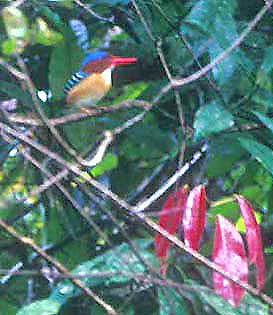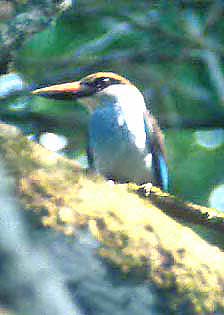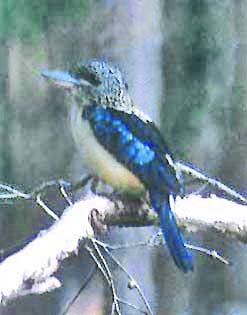
a web page by Don Roberson |
TREE KINGFISHERS Halcyoninae Kookaburras, paradise-kingfishers, and allies |
|||
|
|||
The subfamily includes such colorful characters as the paradise-kingfishers. The spectacular shot (below) of Buff-breasted Paradise-Kingfisher is by Hans & Judy Beste. This adult is flying from its nest in a termite mound. It breeds in Australia and migrates to New Guinea for the austral winter. |
|||
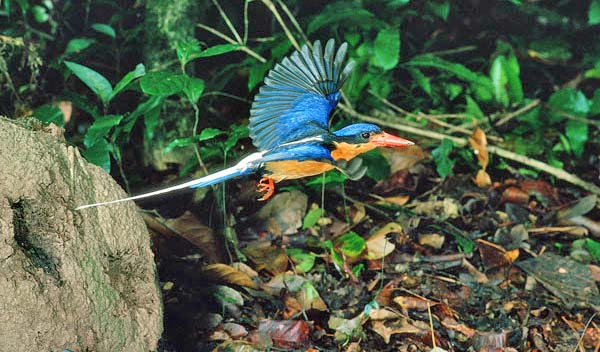 |
|||
Including Buff-breasted, New Guinea is the home to five species. Brown-headed Paradise-Kingfisher (below right, in an amazing digiscope shot by David Fisher) lives in the foothill forests of the southeast. Three more species are endemics on satellite islands around New Guinea: Kofiau, Numfor, and Biak. Biak Paradise-Kingfisher (right) is lovely sky-blue above and white below, with a long white-tipped tail. All the paradise-kingfishers are long-tailed. They all have bright red bills, and they all tend to be shy and elusive in the forest. It would certainly be an amazing achievement to observe all the paradise-kingfishers in the world. |
|||
|
|||
A nomenclatural note: Sibley & Ahlquist (1990), Sibley & Monroe (1990), and Fry, Fry & Harris (1992) all termed this family the Dacelonidae, obviously named after the first kookaburra. Woodall (2001) used the term Halcyoninae for the groups (which he considered a subfamily), as apparently the names have equal priority. The used of Halcyonidae (or Halcyoninae, if a subfamily) has been followed by most authors since (e.g., Dickinson 2003, Moyle 2006). |
|||
|
|
|||
The Tree Kingfishers are not "fishers." In the shots of Buff-breasted Paradise-Kingfisher (above ), the adult is bringing an earthworm into its nest. Other species eat frogs, crabs, earthworms, insects, scorpions, snakes and all manner of wiggly creatures. Many have no affinity for water. Indeed, one species — the Red-backed Kingfisher Todirhamphus pyrrhopygia — inhabits the interior deserts of Australia. The Shovel-billed Kingfisher Clytoceyx rex of lowland New Guinea is almost mythical. It it a big kingfisher with this huge shovel-like bill and sits on the forest floor digging up earthworms. It is related to the kookaburras, and is sometimes called Shovel-billed Kookaburra. |
|||
Quite a number of this group vocalize primarily at night or in the pre-dawn. Their thick forest habitat, unobtrusive sit-and-wait behavior, and nocturnal calls make each of them prized and difficult species. Some of the Todirhamphus kingfishers are like this (e.g., Rufous-lored Kingfisher T. winchelli of the Philippines), and all six of the Actenoides kingfishers, which are distributed from the Greater Sundas to the Solomon Islands. Two are endemic to the Philippines and are very difficult to find. The most difficult is the endangered Blue-capped Kingfisher (right). It took a major camping expedition to the montane forests of Mindanao, tapes, much local knowledge and an exceptional guide, to locate it and make even this photograph possible. Shown below are three other difficult-to-see or local kingfishers from disparate corners of the Old World tropics: Banded Kingfisher (below left) of southeast Asia and Greater Sundas; Blue-breasted Kingfisher (below center), a deep forest species of central Africa (this one photo'd on the island of Príncipe); and Spangled Kookaburra (below right), restricted to the trans-Fly savanna of s. New Guinea and the Aru Islands. Note how difficult it can be to spot the very colorful Banded Kingfisher among the many-hued leaves of a tropical forest. It, like many other difficult kingfishers, is best located by voice. |
|||
|
|||
On a trip to Borneo in 2003, I spent one day hiking up unrelentingly steep trails through humid tropical jungle near Poring Hot Springs. For a middle-aged desk jockey with glasses, this was like a death march. My shirt and cap were drenched with sweat and my glasses constantly fogged. But the one grace note was during the return journey down the mountain. I stopped to catch my breath and to try a walkie-talkie call to Rita back at the springs. That mission accomplished, I looked around before heading off again and found that a spectacular Rufous-collared Kingfisher Actenoides concretus was perched at eye level just a few feet down the trail. It was a female with buffy underparts, a blue moustache, and green back with big buffy spots across the mantle. She seemed oblivious to me as she systematically considered the forest floor below, searching for prey. It was a magical time. This is one of those incredibly hard-to-see species that lives inside the forest; my one prior experience had been with a bird tape-recorded in by Ben King in Sumatra years before. Now, I had found my own, and it made the whole damn death-march worthwhile . . . . |
|||
Photos: Hans & Judy Beste graciously provided some of the best photos on this page: Laughing Kookaburra Dacelo novaeguineae and the two photos of a nesting Buff-breasted Paradise-Kingfisher Tanysiptera sylvia, which was photographed in n. Queensland, Australia, about 1978. David Fisher digiscoped the Brown-headed Paradise-Kingfisher Tanysiptera danae in Variata Nat'l Park, Papua New Guinea, in Oct 2007. The Biak Paradise-Kingfisher Tanysiptera sylvia was on Biak I., Indonesia, on 17 July 1994. Blake Matheson photographed the White-throated Kingfisher Halcyon smyrnensis at Sablaya, Mindoro, Philippines, in Dec 2005. Both the Blue-winged Kookaburra Dacelo leachii and the Spangled Kookaburra D. tyro, further down the page, were in Wasur Nat'l Park, Papua (then Irian Jaya), Indonesia, in s. New Guinea, in Aug 1994. The Woodland Kingfisher Halcyon senegalensis was in Kruger Nat'l Park, South Africa, in July 1996. The Blue-capped Kingfisher Actenoides hombroni was on Mt. Kitinglad, Mindanao, Philippines, on 24 Dec 2005. The male Banded Kingfisher Lacedo pulchella was at Ketambe, Gunung Leuser Nat'l Park, Sumatra, Indonesia, in Aug 1988. The Blue-breasted Kingfisher Halcyon malimbica was on Príncipe Island, Sao Tome & Príncipe, in July 1996. All photos © Don Roberson, except those attributed to © Hans & Judy Beste, © David Fisher, and © Blake Matheson , and used with permission; all right reserved. Incidentally, Hans & Judy Beste — who took the great shots of Buff-breasted Paradise-Kingfisher — are available to act as guides to difficult Australian birds, esp. those in the northeast, for serious single birders or couples: email them here. Bibliographic note:
Literature cited:
|
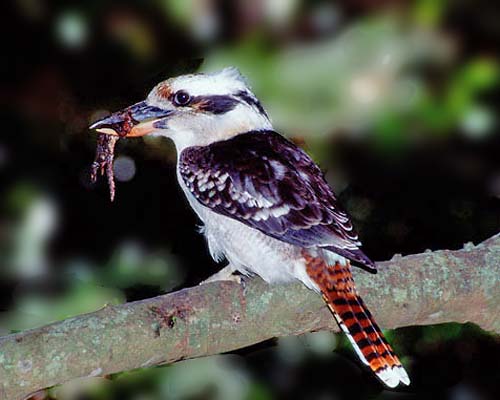 The
Halcyonid Kingfishers, or Tree Kingfishers, are a widespread family in
the Old World tropics. Australasia is the center of their distribution,
with nearly half (24) of all species in Australia and New Guinea and
satellite islands. These include the large kookaburras, exemplified by Laughing Kookaburra (left, a photo with prey taken by Hans & Judy Beste). There are four species of Dacelo kookaburras in Australia and New Guinea.
The
Halcyonid Kingfishers, or Tree Kingfishers, are a widespread family in
the Old World tropics. Australasia is the center of their distribution,
with nearly half (24) of all species in Australia and New Guinea and
satellite islands. These include the large kookaburras, exemplified by Laughing Kookaburra (left, a photo with prey taken by Hans & Judy Beste). There are four species of Dacelo kookaburras in Australia and New Guinea. 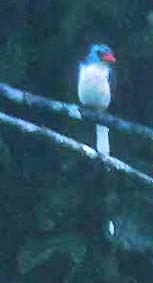 The eight species of paradise-kingfishers in the genus Tanysiptera
are among the great birds of the world. All are lowland forest species
that use termitaria for nests. Most use arboreal ones, but the Buff-breasted Paradise-Kingfisher (both above & below left, by the Bestes), often use termitaria on the ground.
The eight species of paradise-kingfishers in the genus Tanysiptera
are among the great birds of the world. All are lowland forest species
that use termitaria for nests. Most use arboreal ones, but the Buff-breasted Paradise-Kingfisher (both above & below left, by the Bestes), often use termitaria on the ground. 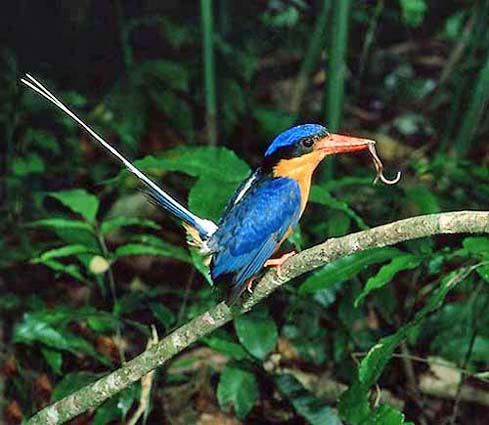
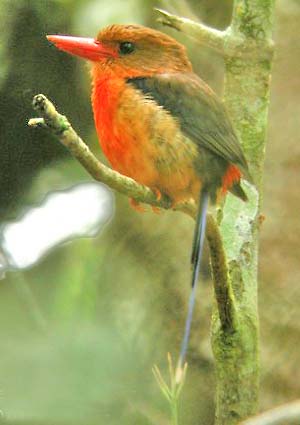
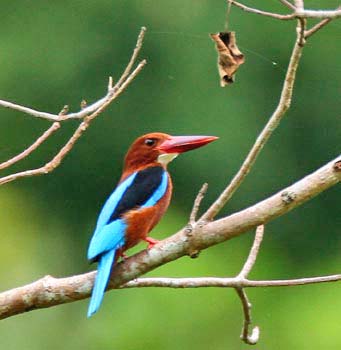 Another red-billed species in the Halcyonidae is White-throated Kingfisher
(left, a fine shot by Blake Matheson), but it is a widespread Asian
species, distributed from the Indian subcontinent to the Greater Sundas
and the Philippines (where this shot was taken).
Another red-billed species in the Halcyonidae is White-throated Kingfisher
(left, a fine shot by Blake Matheson), but it is a widespread Asian
species, distributed from the Indian subcontinent to the Greater Sundas
and the Philippines (where this shot was taken).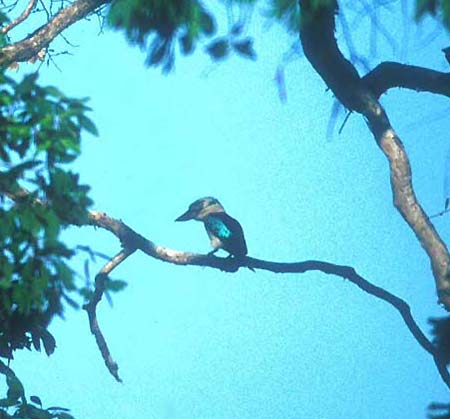 The
Tree Kingfishers eat a wide variety of insects and arthropods, but are
omnivorous and will eat what they can catch. The larger size and heavy
bills of kookaburras allow them to eat snakes, lizards, and a broad
spectrum of small birds and mammals, but they, too, are primarily
insectivores. Blue-winged Kookaburra (right) is from northern Australia and southern New Guinea. As shown, it may perch quite high up in the canopy.
The
Tree Kingfishers eat a wide variety of insects and arthropods, but are
omnivorous and will eat what they can catch. The larger size and heavy
bills of kookaburras allow them to eat snakes, lizards, and a broad
spectrum of small birds and mammals, but they, too, are primarily
insectivores. Blue-winged Kookaburra (right) is from northern Australia and southern New Guinea. As shown, it may perch quite high up in the canopy.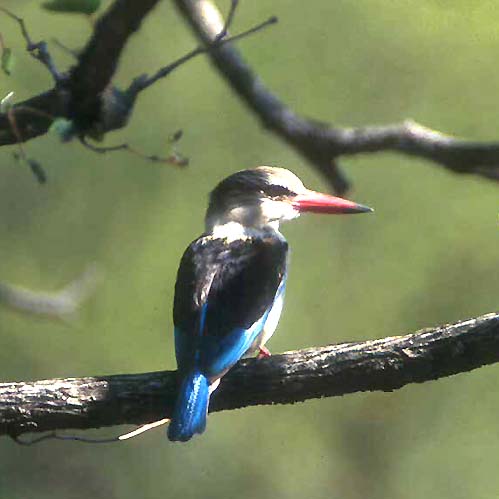 Not
all of the Halcyonid or Tree Kingfishers are restricted to Asia or
Australasia. Africa has its share. Many are found far from water in a
variety of wooded habitats ranging from open savanna to dense tropical
lowland forests. Woodland Kingfisher (left) of sub-Saharan Africa is a good example.
Not
all of the Halcyonid or Tree Kingfishers are restricted to Asia or
Australasia. Africa has its share. Many are found far from water in a
variety of wooded habitats ranging from open savanna to dense tropical
lowland forests. Woodland Kingfisher (left) of sub-Saharan Africa is a good example.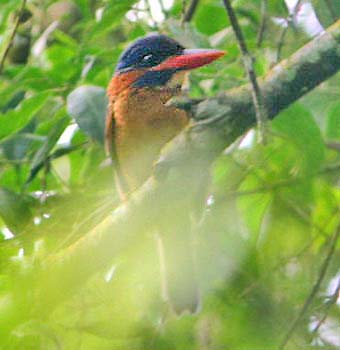 Shovel-billed
Kingfisher is one of the most difficult species to observe, and only by
a few lucky birders when they stumbled across one. It hunts mostly a
dusk, making it even more mysterious. Similarly, the odd Hook-billed
Kingfisher Melidora macrorrhina of New Guinea is mostly nocturnal, and thus more often heard than seen.
Shovel-billed
Kingfisher is one of the most difficult species to observe, and only by
a few lucky birders when they stumbled across one. It hunts mostly a
dusk, making it even more mysterious. Similarly, the odd Hook-billed
Kingfisher Melidora macrorrhina of New Guinea is mostly nocturnal, and thus more often heard than seen.